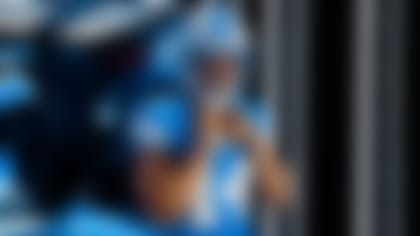Which team best fits the following descriptions: the Pittsburgh Steelers or the Baltimore Ravens?
- In order to succeed, their opponent's run game must be nullified.
- Regardless of the situation, their opponent's quarterback will get hit.
- Offensively, success in their running game is a must.
- Special teams, as far as determining field position, plays a huge role.
Both teams manage games on offense, think they will win every game, and keep seismologists on the ready when they violently collide together twice each season.
There are minor differences, most notably their current records: Pittsburgh 10-3, Baltimore 9-4. Even that can be leveled should Baltimore exact revenge for a 23-20 overtime loss earlier this season.
While both sides will claim they are more opposite than they appear, Newsome doesn't downplay the similarities. In fact, he went into details as to the genesis of what caused these teams to morph into mirror images. There might not be two teams as close in personnel, approach and attitude as Baltimore and Pittsburgh, which is why nearly every time they play, it's ultra-competitive.
How it came to be
"There was a point and time when we started putting our defense together, where if we wanted to compete, we had to deal with teams that had mobile quarterbacks," Newsome said. "We had to play against Kordell Stewart (Pittsburgh) and Mark Brunell (Jacksonville) and Steve McNair (Tennessee). That means we had to get players who could run sideline to sideline and tackle. I'm sure Pittsburgh felt the same way."
Both teams preferred using a 3-4 scheme, although the Ravens sometimes flexed into a 4-3. Even so, the emphasis on dominant defensive-line play to keep offensive linemen off athletic linebackers and ball-hawking defensive backs was a premium. It's been the model in Pittsburgh for decades. Since Baltimore moved from Cleveland in 1996, the Ravens have taken note.
Baltimore and Pittsburgh have acquired and produced more dominating linebackers and defensive backs than any team in the NFL in recent history. The players who stack those final two levels of defense are already being talked about as some of the best of all-time.
Ray Lewis or James Harrison? Bart Scott or LaMarr Woodley? Ed Reed or Troy Polamalu? They are big hitters, sure tacklers and big-time playmakers who force and score off turnovers. Check the Pro Bowl results next week. Those players will occupy several AFC spots for the NFL's annual all-star game.
Coaches
Last season, the Steelers hired energetic Mike Tomlin, then 34, after serving just one season as defensive coordinator with the Minnesota Vikings, when longtime coach Bill Cowher resigned. Baltimore hired John Harbaugh, 46, a first-year secondary coach from the Philadelphia Eagles, when longtime coach Brian Billick was fired after the 2007 season.
Harbaugh and Tomlin were relatively obscure before getting their first head-coaching jobs and their readiness was questioned. All they've done is win. Tomlin's record is 20-9. Harbaugh, five games over .500 with three remaining, is one of four rookie head coaches boasting winning records (Atlanta's Mike Smith, Washington's Jim Zorn and Miami's Tony Sparano are the others).
Largely helping their transitions were the retention of longtime, well-respected defensive coordinators; Pittsburgh's Dick LeBeau and Baltimore's Rex Ryan -- two of the best in the business.
"Continuity was important," Newsome said. "You're talking about two (head coaches) that came from different defensive systems that opted to stay with what was here and add some things they liked. Mike came from a Tampa 2 background and John knew what was working in Philadelphia."
The quarterbacks
"When Ben Roethlisberger was a rookie (in 2004), they didn't want to play him; they had Tommy Maddox," Newsome said. "We didn't plan to start (rookie) Joe Flacco this year. We wanted either Kyle (Boller) or Troy (Smith) to be the starter. We knocked Maddox out and they had to put Roethlisberger in. They went on to get the win and get to the playoffs. Kyle got hurt and Troy got sick before the season and it's worked out thus far for Flacco.
"There were games when Roethlisberger would throw 15, 16 passes. That's the same thing we're doing with Flacco. Both team's identity is to run it down your throat."
Roethlisberger, in his fifth season out of Miami (Ohio), has only thrown 24 more passes in 2008 than Flacco, the rookie from Delaware. He's completed 225 passes to Flacco's 212. Touchdowns? Big Ben 14, Flacco 13. The rookie's passer rating is 81.3. The veteran's is 80.1.
The main difference
There were expectations for Pittsburgh to keep getting better, as it has. Baltimore was picked to finish last in the AFC North again, behind not only the Steelers, but Cleveland and Cincinnati.
"We were 13-3 in 2006, but last season our quarterback (McNair) got hurt in the first game and it was downhill from there," Newsome said. "We had a lot of injuries at key positions. ... You don't want to use injuries as an excuse but we had them at positions where it made things tough for us to win.
"Things have worked out -- so far. We've had some good luck with our rookie quarterback and our guys have played very well. If you would have told me before the season we'd have nine wins, I would have taken that right there. Now we're there for the division. Like I said, things have worked, so far. We'll see how I'm feeling Sunday, about 7:30-8 when this game is over."




